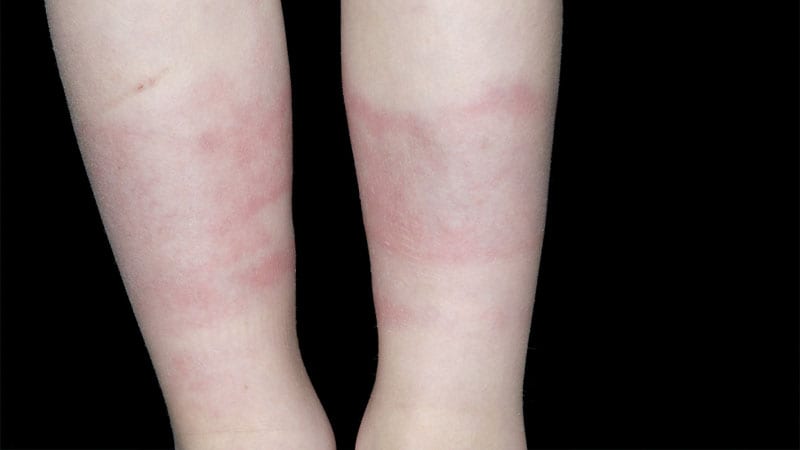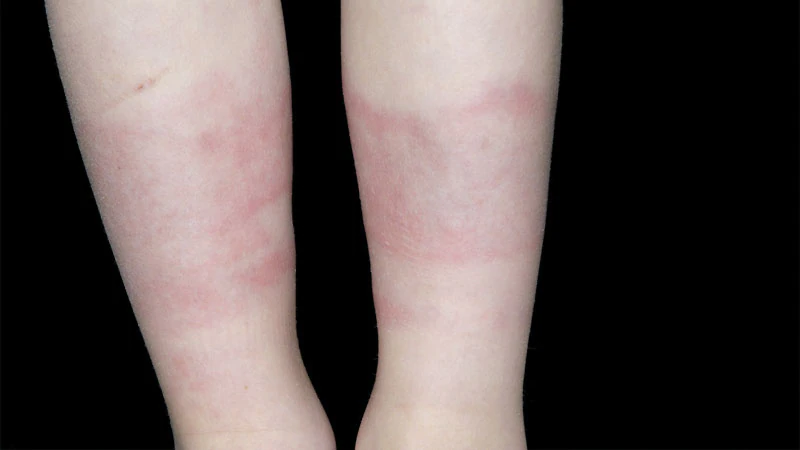
In children, the rare disorder cold urticaria (coldU) tends to persist for years and carry an elevated risk for anaphylaxis, a study from Canada reports.
ColdU often affects young adults but can occur at any age. “Data on coldU in children are sparse,” the authors write in Pediatric Allergy and Immunology. For people with coldU, exposure to cold can trigger a red, itchy, allergic skin rash, swelling, and possibly anaphylaxis.

Dr William Anderson III
“This study demonstrated that pediatric patients with cold-induced urticaria are more likely to have more-difficult-to-control disease if they have concomitant chronic spontaneous urticaria (CSU), and they are more likely to have cold-induced anaphylaxis if they have elevated eosinophils,” William C. Anderson III, MD, an associate professor of pediatrics, allergy, and immunology at the University of Colorado Anschutz Medical Campus in Aurora, told Medscape Medical News. He was not involved in the study.
“A significantly higher proportion of cold-induced urticaria patients had comorbid asthma and atopic dermatitis compared to chronic spontaneous urticaria patients,” Anderson added in an email.
More Data Are Needed on ColdU in Children
Lead study author Connor Prosty, BSc, a medical student at McGill Faculty of Medicine and Health Sciences in Montreal, Quebec, Canada, and his colleagues evaluated data from 52 prospectively enrolled consecutive children with coldU. The patients were treated in one academic pediatric hospital and allergy clinic between 2013 and 2021, and their records were maintained in the institution’s chronic urticaria registry.
The researchers collected data on severity, comorbidities, laboratory values, management, and demographics at baseline and in annual evaluations. To compare children with coldU to those with only CSU, they extracted data from children in a previous study that had used the same registry.
Slightly more than half the children with coldU recruited for the study were girls, and the median age at symptom onset among all participants was 9.5 years. Their coldU triggers included swimming, cold weather or air, and cold food or drink. Most patients were taking second-generation H1-antihistamines (sgAHs) to treat the condition.
-
In patients taking sgAHs, well-controlled disease was negatively linked with accompanying CSU (adjusted odds ratio=0.69; 95% CI, 0.53 – 0.92).
-
Elevated eosinophils were linked with cold-induced anaphylaxis (adjusted odds ratio=1.38; 95% CI, 1.04 – 1.83), which occurred in 17.3% of patients.
-
The resolution rate of coldU — 4.8 per 100 patient-years — was lower than that of CSU (adjusted hazard ratio=0.43; 95% CI, 0.21 – 0.89).
The authors acknowledge limitations of their study, including the small sample size and the roughly 4- to 8-month wait for care, during which cases may have resolved before patients were recruited into the study. Also, four (7.7%) patients were lost to follow-up; for around one quarter of patients, lab values were missing; and the urticaria control test that all participants underwent was not validated for children younger than 12 years.
Study Results Help Doctors Plan Care With Patients and Their Families
Amin Kanani, MDCM, FRCPC, a clinical associate professor in the Faculty of Medicine and the head of the Division of Allergy and Clinical Immunology at the University of British Columbia in Vancouver, British Columbia, Canada, told Medscape Medical News that treating cold urticaria can be challenging.

Dr Amin Kanani
“This study identified important prognostic factors for this condition in children,” he said in an email. “Cold urticaria can last for years and was longer in children who had concomitant chronic spontaneous urticaria. Also, eosinophilia was identified as a marker that predicts cold-induced anaphylaxis, a feared complication of this condition.”
Kanani, who was not involved in the study, added, “Although the sample size was small, this study adds to the growing body of knowledge that currently exists on cold urticaria, and it aids in the management of this disease in children.”
For Anderson, the results of the study help answer questions that parents of children with coldU often ask: How long will it last? What are the odds of my child having anaphylaxis? Are there any tests that can screen for these risks?
The results can help healthcare providers manage coldU in children, and they can be used in shared decision-making with families, Anderson recommended.
“While cold-induced urticaria is rare, approximately 1 in 6 patients developed cold-induced anaphylaxis. Knowing this, pediatricians can educate families on signs, symptoms, and potential risk of cold-induced anaphylaxis,” he advised. “Doctors can obtain screening eosinophil counts to help inform the risk and provide anticipatory guidance on the potential duration of the condition, and they can potentially prescribe epinephrine autoinjectors.”
The authors recommend further related research, including multicenter studies to investigate factors linked with coldU resolution.
Information regarding funding for the study was not provided. Several authors and Anderson have financial involvements with pharmaceutical companies not related to this study. Prosty and Kanani declare no conflicts of interest with the study.
Pediatr Allergy Immunol. Published online March 3, 2022. Abstract
For more news, follow Medscape on Facebook, Twitter, Instagram, and YouTube.
